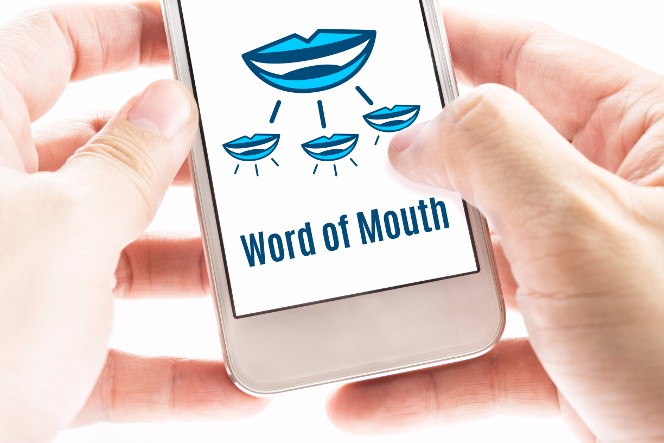Marketers and business owners are always looking for new ways to reach their target audience and get to them ahead of their competitors. And so, you’ve probably heard of word-of-mouth marketing—but what is digital word-of-mouth?
Basically, it’s when people use the internet to talk about your brand or product. This can include things like online reviews, social media posts, and even private messages between friends.
Digital word-of-mouth is a powerful tool to help you reach new customers and grow your business. And in this post, we’ll take a closer look at digital word-of-mouth and how you can use it to your advantage.
Who Needs Word-of-Mouth Referrals?
All businesses can benefit from word-of-mouth referrals. For those industries where trust is a critical component of the customer relationship, it must be a big part of their marketing strategy. Businesses that provide technical, legal, financial, and medical services need a strong word-of-mouth strategy to reach prospects and potential future customers.
Why is Word-of-Mouth Important?
We humans have psychological biases that tell us that a great way to make a decision is to look at the decisions of others. Think back to any time you were shopping for a new TV or car; if you’ve done this in the last ten years, then for sure you looked at Google and YouTube for what others were saying about the items you were shopping for.
As social creatures, we humans trust others and follow their recommendations. According to Semrush, 90% of people are likelier to trust a recommended brand—even when that recommendation comes from a stranger! In addition, Word-of-mouth is even more effective than paid ads, resulting in 5X more sales, and word-of-mouth comes first before Facebook, Google, or Twitter.
What Counts as Word-of-Mouth?
From a business perspective, word-of-mouth referrals bring to you:
- Strong Referral
- Social Proof
- Warm Lead
- Human
This will be a strong referral for you, your business, and your products/services to a prospect on your behalf. It provides social proof for your business to that prospect from someone they trust. Word-of-mouth generates a warm lead for your business since the prospect is already predisposed to hear what you have to say.
Most of all, word-of-mouth is human—we are communicators. People like to share information and help each other. Traditional word-of-mouth operates on a one-to-one basis.
What is Digital Word-of-Mouth?
Digital word-of-mouth is very similar but brings one additional, potent component:
- Strong Referral
- Social Proof
- Warm Lead
- Human
- Digital = Reach
Digital word-of-mouth contains the same essential components as traditional word-of-mouth. The main difference is reach.
With the growth of technology and platforms designed to share information, digital word-of-mouth can have a much greater reach than one-to-one, traditional word-of-mouth. For example, if I have my house painted and tell my neighbor what a great job the painter did, that is a one-to-one word-of-mouth referral. However, if I post on my neighborhood Facebook page, that recommendation will go much broader and become a one-to-many word-of-mouth recommendation. The reach has now extended beyond my neighbor and to my entire neighborhood.
What Can You Do to Get More Word-of-Mouth for Your Business?
1. Ask (and ask again!)
Studies have found that 87% of consumers are willing to refer a business. As a business owner, make it a habit to ask your customers for referrals and reviews once they complete a purchase with you. If you don’t receive a response, ask again.
Your customers are busy and may forget your request—don’t be afraid to remind them. Remember that your customers invested in you and want you to succeed. And they are statistically likely to give you referrals to help your business grow.
2. Be easy to refer
Make it easy for your customers to refer you to others. The number one way to do this is to do a great job, make a great product or provide excellent service. If something goes wrong or a mistake is made—own it and do your best to fix it. Perhaps help a busy customer by providing a couple of sentences or paragraphs that capture what your customer would say. Ask them if they would use that to post a review or if you could use it on your website.
Taking notes of what your customers say about you when you talk with them allows you to help them use their own words to help you grow your business.
3. Circle back – send thanks and follow up
This is hugely important: always thank your customers for their reviews, referrals, and testimonials. Your customers are spending the time and effort to do something for you, so make sure they know you appreciate it. If a referral turns into business for you, follow up with the person who referred them to you. Let them know that they gave you a good referral. People want to help you, and they will be pleased to know they were able to connect two people who were a good fit.
The fact that someone they referred will also do business with you validates their good decision to work with you.
So, to recap, the ABCs of word-of-mouth referrals are:
- Ask (and ask again!)
- Be easy to refer
- Circle Back – send thanks and follow up
Wrapping Up
Word-of-mouth hasn’t changed all that much with the evolution of the digital realm. As humans, we are still communicating with each other, only now it involves more tech and social media. Nevertheless, businesses still depend on word-of-mouth, and in the digital age, positive word-of-mouth can be a powerful way to grow.
And, of course, if you want help putting together an effective referral marketing program (or anything else digital marketing related), we at WSI are here to assist. So connect with us today, and let’s get started!


/cdn.vox-cdn.com/uploads/chorus_image/image/62810996/Amm_DeepSentinel_01.0.jpg)

More Stories
TheyDo fires the starting gun on the race to own the customer journey • TechCrunch
How To Develop Buyer Personas: A Crash Course
stocks to buy: 2 top stock recommendations from Aditya Agarwala